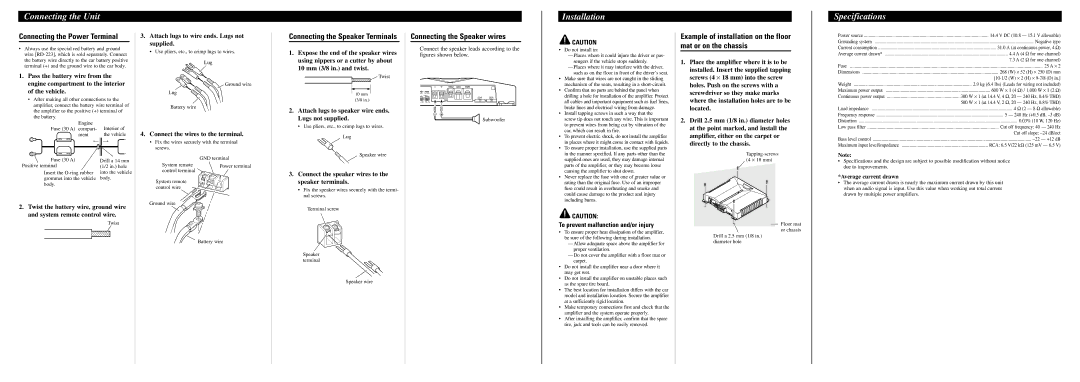
Connecting the Unit
Connecting the Power Terminal
•Always use the special red battery and ground wire
1.Pass the battery wire from the engine compartment to the interior of the vehicle.
•After making all other connections to the amplifier, connect the battery wire terminal of the amplifier to the positive (+) terminal of the battery.
|
|
|
|
|
|
|
| Engine |
|
| Interior of | ||
Fuse (30 A) compart- |
|
| |||||||||||
|
|
|
|
|
|
|
| ment |
|
| the vehicle | ||
|
|
|
|
|
|
|
|
|
|
|
|
|
|
|
|
|
|
|
|
|
|
|
|
|
|
|
|
|
|
|
|
|
|
|
|
|
|
|
|
|
|
|
|
|
|
|
|
|
|
|
|
|
|
|
|
Drill a 14 mm (1/2 in.) hole
Insert the
body.
2.Twist the battery wire, ground wire and system remote control wire.
Twist
3.Attach lugs to wire ends. Lugs not supplied.
• Use pliers, etc., to crimp lugs to wires.
Lug
Ground wire
Lug
Battery wire
4.Connect the wires to the terminal.
•Fix the wires securely with the terminal screws.
| GND terminal |
System remote | Power terminal |
control terminal |
|
System remote |
|
control wire |
|
Ground wire |
|
Battery wire
Connecting the Speaker Terminals
1.Expose the end of the speaker wires using nippers or a cutter by about 10 mm (3/8 in.) and twist.
![]() Twist
Twist
10 mm (3/8 in.)
2.Attach lugs to speaker wire ends. Lugs not supplied.
• Use pliers, etc., to crimp lugs to wires.
Lug
Speaker wire
3.Connect the speaker wires to the speaker terminals.
•Fix the speaker wires securely with the termi- nal screws.
Terminal screw
Speaker terminal
Speaker wire
Connecting the Speaker wires
Connect the speaker leads according to the figures shown below.
Subwoofer
Installation
![]() CAUTION
CAUTION
• Do not install in:
•Make sure that wires are not caught in the sliding mechanism of the seats, resulting in a
•Confirm that no parts are behind the panel when drilling a hole for installation of the amplifier. Protect all cables and important equipment such as fuel lines, brake lines and electrical wiring from damage.
•Install tapping screws in such a way that the
screw tip does not touch any wire. This is important to prevent wires from being cut by vibration of the car, which can result in fire.
•To prevent electric shock, do not install the amplifier in places where it might come in contact with liquids.
•To ensure proper installation, use the supplied parts in the manner specified. If any parts other than the supplied ones are used, they may damage internal parts of the amplifier, or they may become loose causing the amplifier to shut down.
•Never replace the fuse with one of greater value or rating than the original fuse. Use of an improper fuse could result in overheating and smoke and could cause damage to the product and injury including burns.
![]() CAUTION:
CAUTION:
To prevent malfunction and/or injury
•To ensure proper heat dissipation of the amplifier, be sure of the following during installation.
•Do not install the amplifier near a door where it may get wet.
•Do not install the amplifier on unstable places such as the spare tire board.
•The best location for installation differs with the car model and installation location. Secure the amplifier at a sufficiently rigid location.
•Make temporary connections first and check that the amplifier and the system operate properly.
•After installing the amplifier, confirm that the spare tire, jack and tools can be easily removed.
Example of installation on the floor mat or on the chassis
1.Place the amplifier where it is to be
installed. Insert the supplied tapping screws (4 ⋅ 18 mm) into the screw holes. Push on the screws with a screwdriver so they make marks where the installation holes are to be located.
2.Drill 2.5 mm (1/8 in.) diameter holes at the point marked, and install the amplifier, either on the carpet or directly to the chassis.
Floor mat or chassis
Drill a 2.5 mm (1/8 in.) diameter hole
Specifications
Power source | 14.4 V DC (10.8 — 15.1 V allowable) |
Grounding system | Negative type |
Current consumption | 31.0 A (at continuous power, 4 Ω) |
Average current drawn* | 4.4 A (4 Ω for one channel) |
| 7.3 A (2 Ω for one channel) |
Fuse | 25 A ⋅ 2 |
Dimensions | 268 (W) ⋅ 52 (H) ⋅ 250 (D) mm |
| |
Weight | 2.9 kg (6.4 lbs) (Leads for wiring not included) |
Maximum power output | 600 W ⋅ 1 (4 Ω) / 1,000 W ⋅ 1 (2 Ω) |
Continuous power output | 300 W ⋅ 1 (at 14.4 V, 4 Ω, 20 — 240 Hz, 0.4% THD) |
| 500 W ⋅ 1 (at 14.4 V, 2 Ω, 20 — 240 Hz, 0.8% THD) |
Load impedance | 4 Ω (2 — 8 Ω allowable) |
Frequency response | 5 — 240 Hz (+0.5 dB, |
Distortion | 0.03% (10 W, 120 Hz) |
Low pass filter | Cut off frequency: 40 — 240 Hz |
| Cut off slope: |
Bass level control | |
Maximum input level/impedance | RCA: 6.5 V/22 kΩ (125 mV — 6.5 V) |
Note:
•Specifications and the design are subject to possible modification without notice due to improvements.
*Average current drawn
•The average current drawn is nearly the maximum current drawn by this unit when an audio signal is input. Use this value when working out total current drawn by multiple power amplifiers.
